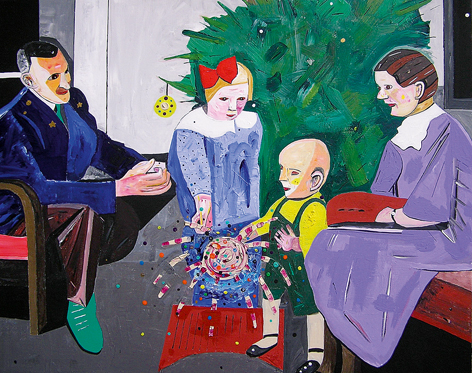|
|
| In Praise of Naivete Vilnis Vējš, artist Works by August Künnapu 06.06.-31.07.2009. Gallery "21" | |
| An Estonian's greeting to Latvians: one of August Künnapu's paintings is named An Estonian Figure Skater, but another - A Latvian Figure Skater. Both feature ladies performing one and the same figure, only in opposite directions: an elevation on one toe, holding the knee of the other leg as high as possible. Arms are spread out wide, the head thrown back. The poses of the skaters emanate pride and joy. However, one of them is performing against the backdrop of a rather gloomy industrial landscape with three chimneys, whilst the other one is shown against green trees and blue skies with a little white cloud. How, when skating in the open - surely it must be winter - did she get a summer landscape behind her? This doesn't worry the Estonian skater. Let's then presume that the trees are conifers, besides, are there any other kinds of trees in Estonia? | |
 August Künnapu. Christmas at Raua Street. Acrylic on canvas. 80x100cm. 2009. Publicity photo | |
| Looking at Künnapu's works makes you want to smile from ear to ear. It appears that I am not the only one. In the introduction of the artist's catalogue one Harry Pye, British curator and critic, proclaims his faith in Künnapu, claims that the artist's works come from the bottom of the heart, and compares them to John Lennon's songs, which he himself has likened to postcards. In the context of contemporary art criticism such lexis sounds, at the very least, suspect. When was last time that you read in an article, for instance, by Inga Šteimane, about something "coming from the bottom of the heart", and who, these days, would consider this an acceptable argument in the evaluation of a work of art? Why does the language of criticism capitulate before Künnapu's paintings?
The version by the said Mr Pye, that Künnapu's paintings are not similar to any other amongst thousands of painters, is quite plausible. Critics nevertheless usually repeat something already heard in relation to another, similar work. What can you do, if Künnapu's paintings really are similar to items that critics wouldn't normally comment on: not even postcards, more likely homemade birthday cards made for relatives, or an amateur's first attempts at art, copying photographs of the wife or children, or illustrations for a diary. It's typical that the themes of several pictures tap into a nostalgic past, when these sorts of pastimes had not yet retreated before the entertainments manufactured on an industrial scale. When handicrafts had their place and sometimes even a great significance. Usually symbolic, and often - ritual. | |
 August Künnapu. People. Acrylic on canvas. 50x70cm. 2009. Publicity photo | |
|
However, the art created for one's own pleasure, like the singing at home parties, usually does not make it to the public realm, and therefore does not attract criticism. Who would ever dare to criticise, for instance, the above-mentioned figure skaters for their moves not being graceful enough? The only approach to the analysis of Künnapu's paintings could be to place them into the category of "naïve" art, but the artist himself has repeatedly rejected this point blank. Furthermore, the definition of what is naïve art is so contradictory, that a proper evaluation cannot be made.The characteristic feature of Künnapu's works to inspire confidence is not among the arsenal of weapons available in art, it would seem. Who then believes in art? Yet it is to be rated highly in personal relations, so it would not be an overstatement to declare that a viewer's relationship with each concrete painting develops as if with a person. More to the point, one gets an impression that, behind the paintings, it is quite easy to see the person who has created them. It is fairly easy to visualise the person to whom his childhood photos were so precious, that he felt an urge to re-draw them by hand and to colour them in. A man who likes a picture in a magazine so much that he wants to "make" one, too. For example, a portrait of Grace Jones. At the same time, of course, enhancing it or making some changes. An enthusiast who, all on his own, tries to find out how to get movement into an image, and to this end he, for instance, draws the back-ground for a pole-vaulter as a ripple of abstract squares (Flying Woman). It's not difficult for the viewer to find errors and failures in the work of the imaginary artist, when, for instance, he has failed to depict a front view of a ski, or that an image of what had been intended to be a beautiful girl has come out rather ugly. But double the joy and satisfaction, when, by a hair's breadth, the artist has succeeded in balancing the figures in the foreground and in the background so they don't overlap. Whether the "author" created by the viewer's imagination is or isn't the real August Künnapu, or only the fruits of a perfect artistic strategy will, most likely, remain an open question, still one gets an impression that the artist's most pronounced characteristics are naivete and decency. Only with these it is possible to restore the belief in the present day world of art that a painting "represents" the depicted object, and that the artist is an honest switchman in this process. It's a long time since ideas like that were a consideration in contemporary art, however, as it turns out, they seem to be very much in demand. Otherwise, on meeting a painter, would people still ask: "Will you draw me?" and, seeing the result, would they speculate: "Could I also do that, I wonder?". Künnapu's paintings inspire the hope that you could indeed. /Translator into English: Sarmīte Lietuviete/ | |
| go back | |







